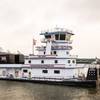Guido Perla and Assoc., Inc., has recently completed contract design for Crowley Maritime Corp.'s subsidiary Vessel Management Services' series of three PRT Class (Prevention and Response) Tanker Assist/General Towing Z-Drive tugs. GPA is also furnishing complete detail modular construction engineering for the 140 ft. x 10,192 hp Caterpillar-powered PRT Class, which are currently under construction at Dakota Creek Industries in Anacortes, Wash.
The vessels are designed as diesel powered twin Z-Drive propulsion tugboats, outfitted for tanker rescue, ocean towing, emergency oil spill response, fire fighting and harbor service. Propulsion is provided by two Caterpillar 3612B diesel engines, each rated 5,096 bhp @ 900 rpm, driving two Kamewa Aquamaster U.S. 5001 Azimuth Z-Drive propulsion units. Electric power requirements are met by two Caterpillar 3306DITA diesel-driven 190 kW generators.
The main tow winch is a Markey Machinery Company TDS-40, with capacity of 2,500 ft. of 2.5 in. wire rope diesel driven via a Detroit Diesel Corp. 8V71. Markey is also providing a WYWD-20-48 combination bow winch/anchor windlass for 1.25 in. chain and 400 ft. of nine-in. circumference softline. Retractable hydraulic tow pins will be provided at the stern of the vessel. Pumps off the front PTO of the Caterpillar 3306DITA generator engine supply hydraulic power.
Willis Bearings Still Going Strong
The Willis Rotary Bearing, introduced by E. J. Willis Co., was developed during World War II when the need arose for a bearing which would not wear out a prop shaft, no matter what material was used for shafting. The Willis bearing attached to and rotated with the prop shaft, eliminating shaft wear.
Palmer Products Inc. has bought the rights to the Willis bearing in order to develop a special version of it for vertical turbine pumps used in demanding geothermal applications. Now called the Shaft Saver, the bearing has been redesigned to replace most sizes of cutless type prop shaft bearings and is being reintroduced to the marine market. Its frictionless operations is reported to allow for increased performance and higher shaft speed while using fewer horsepower and saving fuel.
Sponsored Content
Lower carbon intensity fuels to support your operations

Subscribe for
Maritime Reporter E-News
Maritime Reporter E-News is the maritime industry's largest circulation and most authoritative ENews Service, delivered to your Email five times per week










